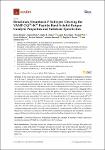Botulinum Neurotoxin F Subtypes Cleaving the VAMP-2 Q58–K59 Peptide Bond Exhibit Unique Catalytic Properties and Substrate Specificities
Sikorra, Stefan
Skiba, Martin
Dorner, Martin B.
Weisemann, Jasmin
Weil, Mirjam
Valdezate, Sylvia
Davletov, Bazbek
Rummel, Andreas
Dorner, Brigitte G.
Binz, Thomas
In the recent past, about 40 botulinum neurotoxin (BoNT) subtypes belonging to serotypes A, B, E, and F pathogenic to humans were identified among hundreds of independent isolates. BoNTs are the etiological factors of botulism and represent potential bioweapons; however, they are also recognized pharmaceuticals for the efficient counteraction of hyperactive nerve terminals in a variety of human diseases. The detailed biochemical characterization of subtypes as the basis for development of suitable countermeasures and possible novel therapeutic applications is lagging behind the increase in new subtypes. Here, we report the primary structure of a ninth subtype of BoNT/F. Its amino-acid sequence diverges by at least 8.4% at the holotoxin and 13.4% at the enzymatic domain level from all other known BoNT/F subtypes. We found that BoNT/F9 shares the scissile Q58/K59 bond in its substrate vesicle associated membrane protein 2 with the prototype BoNT/F1. Comparative biochemical analyses of four BoNT/F enzymatic domains showed that the catalytic efficiencies decrease in the order F1 > F7 > F9 > F6, and vary by up to a factor of eight. KM values increase in the order F1 > F9 > F6 ≈ F7, whereas kcat decreases in the order F7 > F1 > F9 > F6. Comparative substrate scanning mutagenesis studies revealed a unique pattern of crucial substrate residues for each subtype. Based upon structural coordinates of F1 bound to an inhibitor polypeptide, the mutational analyses suggest different substrate interactions in the substrate binding channel of each subtype.

